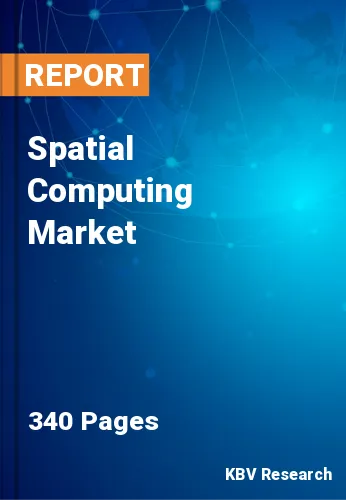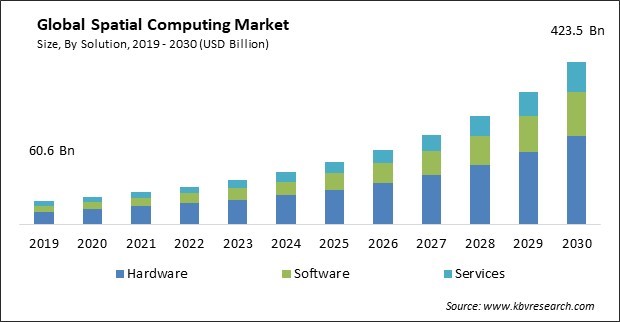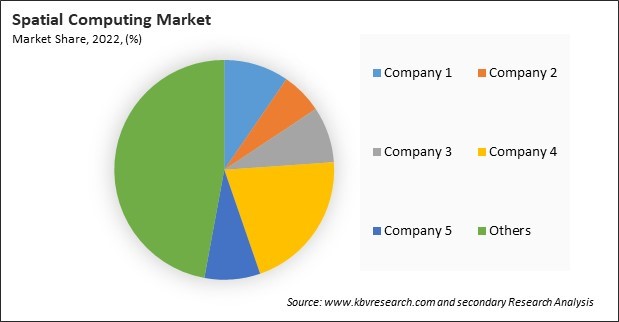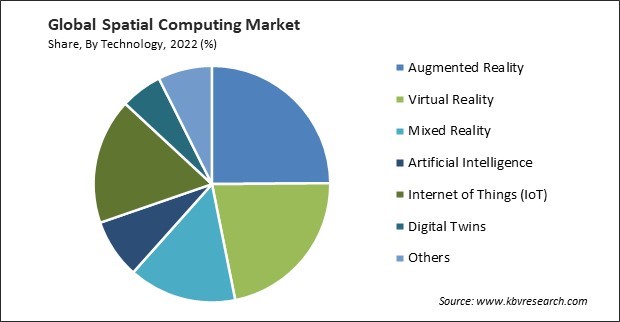
The Global Spatial Computing Market size is expected to reach $423.5 billion by 2030, rising at a market growth of 20.3% CAGR during the forecast period.
Consumer electronics devices like tablets and laptops are increasingly used in educational settings. Spatial computing apps and educational content can provide students with immersive learning experiences. Consequently, the consumer electronics segment would generate approximately 1/5th share of the market by 2030. Spatial computing apps and educational content can provide students with immersive learning experiences. Consumer electronics companies have introduced VR headsets like Oculus Rift and HTC Vive, AR headsets like Microsoft HoloLens, and AR glasses like Google Glass. As consumer demand for immersive and interactive experiences grows, innovation and investment in developing spatial computing applications and hardware drive innovation. Some of the factors affecting the market are significant improvements in hardware, expansion of the gaming and entertainment industry, and privacy and security concerns.

Advances in hardware, including augmented reality (AR) and virtual reality (VR) headsets, significantly impact the market. These improvements include higher-resolution displays, more powerful processors, better tracking capabilities, and enhanced ergonomics. As hardware becomes more capable and affordable, it drives greater adoption. More powerful and energy-efficient processors like CPUs and GPUs enable spatial computing devices to handle complex computational tasks, render high-quality graphics, and run sophisticated algorithms in real-time. Moreover, the gaming and entertainment industry has been a significant driver. VR gaming and immersive entertainment experiences continue to attract consumers and drive demand for VR headsets and content. Augmented reality gaming blends the virtual and real worlds, overlaying digital elements onto the user's physical environment. AR games encourage players to move and explore their surroundings while interacting with virtual objects and characters. Popular examples include Pokémon GO and AR escape room games. As these technologies become more integrated into the automotive ecosystem, they have the potential to drive significant growth in the market, benefiting both the automotive sector and consumers.
However, Spatial computing technologies involve sensors and cameras that capture and process data about the user's environment. Ensuring the privacy and security of this data is crucial to building trust among users and addressing potential privacy-related challenges. Spatial computing devices often collect data about users' surroundings, movements, and interactions. This data includes images, videos, and sensor readings. Ensuring the privacy of this data is crucial to protect users from unauthorized surveillance and data breaches. Therefore, regulatory and ethical issues present significant challenges that can impede the growth and adoption of the market.

The leading players in the market are competing with diverse innovative offerings to remain competitive in the market. The above illustration shows the percentage of revenue shared by some of the leading companies in the market. The leading players of the market are adopting various strategies in order to cater demand coming from the different industries. The key developmental strategies in the market are Acquisitions, and Partnerships & Collaborations.
Based on technology, the market is classified into artificial intelligence, augmented reality, virtual reality, mixed reality, Internet of Things (IoT), digital twins, and others. In 2022, the augmented reality segment witnessed the largest revenue share in the market in 2022. AR augments the real-world environment by superimposing digital information, such as 3D objects, images, video, and textual data, onto the user's view, typically via mobile devices or AR spectacles. The pervasive adoption of smartphones and tablets equipped with sophisticated cameras and sensors has made augmented reality (AR) accessible to a wide audience. Lightweight and more aesthetically pleasing AR glasses have been created due to technologies and miniaturization. Microsoft (HoloLens), Google (Google Glass), and Apple (VisionPro) are investing in augmented reality (AR) spectacles.

On the basis of end user, the market is divided into healthcare, education, architecture, engineering, & construction (AEC), aerospace & defense, automotive, gaming, consumer electronics, government & public sector, information technology, energy & utilities, and others. In 2022, the healthcare segment dominated the market with maximum revenue share. Spatial computing technology adoption is significantly increasing in the healthcare segment. Virtual reality (VR) and magnetic resonance (MR) simulations provide hands-on experiences for surgical training, patient examination, and medical interventions, allowing healthcare professionals to improve their abilities and expertise without risking patient security.
By solution, the market is categorized into hardware devices, software, and services. The software segment covered a considerable revenue share in the market in 2022. In addition to hardware devices, software solutions play a significant role in expanding the market because they enable the creation and deployment of immersive and interactive virtual reality, augmented reality, and mixed reality experiences. Content creation tools are software programs that enable developers, designers, and artists to create these experiences. These tools include 3D modeling and animation software, gaming engines, and authoring tools for VR, AR, and MR content.
| Report Attribute | Details |
|---|---|
| Market size value in 2022 | USD 99.4 Billion |
| Market size forecast in 2030 | USD 423.5 Billion |
| Base Year | 2022 |
| Historical Period | 2019 to 2021 |
| Forecast Period | 2023 to 2030 |
| Revenue Growth Rate | CAGR of 20.3% from 2023 to 2030 |
| Number of Pages | 340 |
| Number of Table | 470 |
| Report coverage | Market Trends, Revenue Estimation and Forecast, Segmentation Analysis, Regional and Country Breakdown, Market Share Analysis, Companies Strategic Developments, Company Profiling |
| Segments covered | Solution, Technology, End User, Region |
| Country scope | US, Canada, Mexico, Germany, UK, France, Russia, Spain, Italy, China, Japan, India, South Korea, Singapore, Malaysia, Brazil, Argentina, UAE, Saudi Arabia, South Africa, Nigeria |
| Growth Drivers |
|
| Restraints |
|
Region-wise, the market is analysed across North America, Europe, Asia Pacific, and LAMEA. In 2022, the Asia Pacific region acquired a significant revenue share in the market. Asia Pacific is a diversified and developing market with a sizable population, significant technological advancements, and rising use of digital technology. Smart technologies, such as wearables, tablets, and smartphones, have been quickly embraced throughout the region. These devices are the primary platforms for gaining access to spatial computing experiences. In countries such as China, India, Japan, and South Korea, the increasing prevalence of smart devices has generated a substantial user base for computing devices.
Free Valuable Insights: Global Spatial Computing Market size to reach USD 423.5 Billion by 2030
The market research report covers the analysis of key stakeholders of the market. Key companies profiled in the report include Apple Inc., Avegant Corporation, Blippar Group Limited, Seiko Epson Corporation, Google LLC, HTC Corporation, Lenovo Group Limited, Magic Leap, Inc., Microsoft Corporation, NVIDIA Corporation.
By End User
By Solution
By Technology
By Geography
This Market size is expected to reach $423.5 billion by 2030.
Significant improvements in hardware are driving the Market in coming years, however, Privacy and security concerns restraints the growth of the Market.
Apple Inc., Avegant Corporation, Blippar Group Limited, Seiko Epson Corporation, Google LLC, HTC Corporation, Lenovo Group Limited, Magic Leap, Inc., Microsoft Corporation, NVIDIA Corporation.
The expected CAGR of this Market is 20.3% from 2023 to 2030.
The Hardware segment is leading the Market by Solution in 2022; thereby, achieving a market value of $230.8 billion by 2030.
The North America region dominated the Market by Region in 2022, and would continue to be a dominant market till 2030; thereby, achieving a market value of $145.8 billion by 2030.
Our team of dedicated experts can provide you with attractive expansion opportunities for your business.
